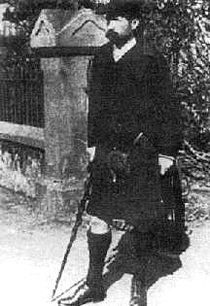The Biography of Sir Hugh Munro 1856 – 1919
Hugh Thomas Munro was born in 1856. After a spell in Stuttgart learning German (when he was introduced to the Alps), followed by a business course in London and a stint as a cavalryman in the Basuto War, he settled down to manage the family estate of Lindertis near Kirriemuir. From here he undertook long expeditions into the hills, often in winter when estate business was less demanding; his first recorded 3000ft peak was Ben Lawers in May 1879. Ten years later he was among the founders of the Scottish Mountaineering Club, eventually becoming President.

In 1891 Sir Hugh Munro was asked by the editor of the Scottish Mountaineering Club’s Journal to list all the hills in Scotland above 3000 feet. The choice of Munro was no accident. He was known as a collector, and his business training had taught him the benefits of meticulous classification. He was fascinated by mountain topography and was a compulsive note-taker, particularly regarding the views from a summit. He was blessed with the stamina and tenacity required for long expeditions into the hills. And last but not least, he flung himself with enthusiasm into everything he undertook.
Although lists of 'principal mountains' had been made before these were mainly for the benefit of tourists or shooting tenants. Munro’s Tables were specifically aimed at the mountaineer. They are systematic, thorough, and they have two unique features: the seventeen Sections, which are based on the natural divisions of the landscape, with mountain groupings, and points of access, very much in mind; and the distinction between 'separate mountains' – the Munros - and the 'Tops'. These are the satellites or outliers, elevations subsidiary to the main summits yet felt by Munro to be worthy of inclusion.
Munro's main tools for his task were the Ordnance Survey's one-inch and six inch to the mile maps of Scotland. The one-inch map showed heights in contours (though only at 250ft. intervals); the six-inch map had no contours but gave spot heights for summits and elsewhere. These two sets of data had to be collated. Munro also conferred with fellow club members on the worthiness or otherwise of various humps, bumps, points and protuberances.
The 'Table giving all the Scottish mountains exceeding 3000 feet in height, compiled by Munro' appeared in the S.M.C. Journal, Vol. I no. 6 in September 1891. The list comprised 283 separate mountains (Munros) and a total of 538 tops. These totals are impressively close to today's figures (282 Munros out of 509), even after a century of improved mapping, several revisions and continuous refinements.

If the notion of revising the original Tables seems a bit like tampering with Holy Writ, there is no doubt that Sir Hugh regarded his 1891 list merely as a first attempt. Over the next two and a half decades he constantly checked and modified his data. In 1921, two years after his death, a second version of the Tables appeared largely incorporating his refinements. This listed 276 Munros and a total of 543 Tops. A 1974 version gave 279 Munros and a total of 541 tops. Other versions with modifications appeared in 1981, 1984, 1990 and 1997.
Munro himself was not to climb all the mountains in his list. He died aged 63 in 1919 of pneumonia contracted while running a troop canteen in Provence. Three summits still eluded him. These were Carn an Fhidhleir in Glen Feshie, the Inaccessible Pinnacle on Skye, and Carn Cloich-mhuilinn, in Upper Deeside. This latter summit Sir Hugh was likely leaving for his final Munro. Perhaps sadly it has been 'demoted' to a Top in recent versions of the Tables.
Acknowledgement: Thanks to Gillian Zealand for permission to extract much of this information from her article in The Munro Society Newsletter Number 13 July 2008.